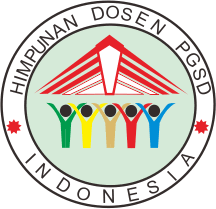Hubungan Literasi Visual dengan Computational Thinking Peserta Didik Kelas V Sekolah Dasar Se-Kecamatan Argomulyo
Abstract
This study aims to determine the relationship between visual literacy and computational thinking among fifth-grade elementary school students in Argomulyo District. Visual literacy refers to students' ability to understand, interpret, and communicate information through visual media, while computational thinking refers to the ability to think logically, systematically, and structurally in solving problems. This study uses a quantitative approach with a correlational method. The population in this study was all fifth-grade students from various elementary schools in the Argomulyo subdistrict, and the sample consisted of fifth-grade students at SDN Cebongan 03, SDN Noborejo 01, SDN Randuacir 02, and SDN Randuacir 03. The sampling technique used was stratified random sampling. Data collection was conducted using an essay-type test. The instruments used were questionnaires and tests that had been validated by experts. The validation techniques used included validity tests and reliability tests. Data analysis techniques used prerequisite analysis tests, namely normality and linearity tests, followed by hypothesis testing using simple correlation tests. The results of this study show that visual literacy and computational thinking have a positive and significant relationship that can be explained through the interconnection between visual literacy and computational thinking. The data analysis results indicate a significant relationship between visual literacy and computational thinking, as evidenced by a significance level of <0.05. This finding suggests that the higher the visual literacy skills of students, the better their computational thinking abilities. Therefore, developing learning that effectively integrates visual elements can be a strategy to enhance students' computational thinking skills at the elementary school level.
Keywords
References
[1] T. U. H. Juldial and R. Haryadi, “Analisis Keterampilan Berpikir Komputasional dalam Proses Pembelajaran,” J. Basicedu, vol. 8, no. 1, pp. 136–144, 2024, doi: 10.31004/basicedu.v8i1.6992.
[2] E. R. Kusumawati and S. Achmad, “Pelatihan computational thinking guru MI se-Kecamatan Pabelan, Kabupaten Semarang,” Penamas J. Community Serv., vol. 2, no. 1, pp. 18–28, 2022, doi: 10.53088/penamas.v2i1.283.
[3] R. Nur Asmah, N. Hasanah, E. Lailan Syamita Lubis, and S. Al Maksum, “Pengaruh metode computational thingking terhadap kemampuan berfikir kritis siswa kelas V SD.”
[4] R. Ardiansyah et al., “Literature Review: Computational thinking dalam pembelajaran IPAS Sekolah Dasar.”
[5] A. Wau, M. Fadilah, J. Hamka, and A. Tawar Barat, “Literatur Review : Analisis Kemampuan Literasi Visual Peserta Didik Pada Pembelajaran Biologi di Sekolah,” & Pend.Bio, vol. 9, no. 1, 2024.
[6] H. T. Linayanti, A. Widyatmoko, and L. Handayani, “Efektifitas penggunaan media interaktif berbasis game edukatif dalam meningkatkan hasil belajar IPA siswa SD,” Didakt. Dwija Indria, vol. 13, no. 3, pp. 378–383, 2023.
[7] S. N. Kane, A. Mishra, and A. K. Dutta, “Preface: International Conference on Recent Trends in Physics (ICRTP 2016),” J. Phys. Conf. Ser., vol. 755, no. 1, 2016, doi: 10.1088/1742-6596/755/1/011001.
[8] R. A. Indah and M. Fadilah, “Literature Review : Pengaruh Media Pembelajaran Literasi Visual Terhadap Hasil Belajar Biologi Siswa SMA,” BIODIK, vol. 10, no. 2, pp. 188–198, Jun. 2024, doi: 10.22437/biodik.v10i2.33803.
[9] M. P. . A. I. N. S. . & S. K. A. Restami, “Pengembangan Media Pembelajaran Berbasis Mobile Learning Untuk Meningkatkan Kemampuan Literasi Visual dan Hasil Belajar. ,” J. Ilm. Pendidik. Citra Bakti, vol. 6, no. 2, pp. 110–120, 2019.
[10] A. N. . M. S. . S. A. . R. H. R. . & Y. W. Saputro, “Meningkatkan keterampilan membaca dan computational thinking siswa melalui media pembelajaran berbasis visual kontekstual,” J. Pendidik., vol. 7, no. 1, pp. 1513–1524, 2024.
[11] & M. M. R. Rusmini, “Peranan visual thinking berbasis computational thinking dalam penyelesaian masalah statistik dan probabilitas,” J. Cendekia J. Pendidik. Mat. , vol. 8, no. 2, pp. 1342–1350, 2024.
[12] Y. N. M. . & M. Hapsari, “Eksplorasi Kemampuan Berpikir Komputasi Siswa SMP Dalam Menyelesaikan Soal Pola Bilangan Ditinjau Dari Gaya Belajar,” J. Pendidik. Mat. dan Mat., pp. 200–207, 2024.
[13] A. Buhamad, R. Alsaffar, and B. Almisad, “The Effect of Different Visual Literacy Patterns of Drawings and Instructional Photos in Developing Concepts for Middle School in State of Kuwait,” Int. J. Digit. Soc., vol. 15, no. 1, pp. 1889–1895, 2024, doi: 10.20533/ijds.2040.2570.2024.0237.
[14] L. . & R. F. Sulistiawati, “Hubungan literasi visual dengan kemampuan abstraksi dalam pemecahan masalah siswa.,” J. Ilmu Pendidik., vol. 5, no. 1, pp. 30–33, 2021.
[15] A. P. Wulandari, “Pengembangan Media Augmented Reality Pada Materi Karya Seni Rupa Daerah Terhadap Literasi Budaya Siswa Kelas V SD Penelitian,” 2025.
Refbacks
- There are currently no refbacks.



